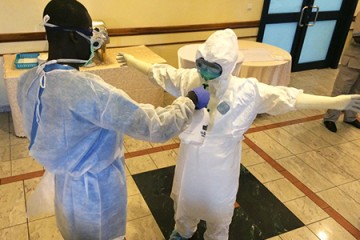Johns Hopkins biomedical engineers have developed a free, browser-based online tool that could speed up the creation of new drugs to treat or prevent Ebola virus infections.
The software, called MuPIT Ebola Edition, enables a researcher to visualize Ebola gene mutations in the context of three-dimensional protein structures. It also offers views of antibody binding sites or epitopes that are situated on protein surfaces. These sites may give researchers new targets for preventive vaccines and serums to treat those who are already infected.
MuPIT is short for Mutation Position Imaging Toolkit.
"Learning more about the mutations and binding sites can be enormously valuable in developing new and better ways to treat Ebola patients and, ideally, to keep the virus from infecting people in the first place," said Rachel Karchin, who supervised the project. Karchin is a Johns Hopkins associate professor of biomedical engineering, a William R. Brody Faculty Scholar, and a core faculty member of the university-s Institute for Computational Medicine.
She added, "Understanding the evolutionary and functional importance of mutations in the Ebola genome is important because it can help us anticipate how the virus will change in the future and then help us to design of vaccines capable of neutralizing the virus and protecting against infection."
Karchin pointed out that many existing vaccines are made by engineering specific antibodies, which are Y-shaped molecules that bind to viral surface proteins and help prevent the virus from replicating and spreading. For example, she said, the drug ZMapp, which was recently used to treat several Ebola-infected health care workers, is a cocktail of three antibodies.
Karchin's team designed its new digital display tool to connect with the new Ebola Genome Browser released recently by the University of California, Santa Cruz. The UCSC browser offers detailed genetic information about the virus. The Johns Hopkins add-on provides 3-D views of Ebola's proteins, making it easier to interpret the functional implications of mutations and their relationship to Ebola virus evolution and its potential vulnerabilities.
The Karchin Lab's MuPIT Ebola edition software was devised in response to a request from UC Santa Cruz bioinformatics researcher David Haussler, who was one of Karchin's graduate faculty advisers. She earned her PhD at the school in 2003.
"The Ebola Genome Browser allows researchers and health care experts around the world to track the mutational adaptations of the virus during the outbreak," Haussler said. "The team at Santa Cruz, led by Jim Kent, creator of the UCSC Human Genome Browser, turned to the Karchin Lab for the software to visualize the changes occurring in the genome in terms of their effects on the virus proteins. It is exciting to see our work in genomics come to life in 3-D using MuPIT. It brings an important new dimension to the Ebola Portal for those battling the outbreak."
Karchin said research suggests that mutations at the virus's antibody-binding sites are important because they can provide clues about how effective a new antibody vaccine may be at combatting a disease such as Ebola. She added that because proteins are three-dimensional molecules, seeing their mutations and epitopes on-screen as 3-D structures can offer important details about their functional and clinical importance.
This first edition of MuPIT Ebola provides visualization of user-specified mutations as well as mutations from 101 viral genome sequences, derived from blood samples taken from Ebola patients in West Africa. It includes functional annotations from the Universal Protein Resource database and epitope sequences from the Immune Epitope and Analysis Resource.
The MuPIT Ebola edition browser can be accessed at http://mupit-ebola.icm.jhu.edu/. "We hope to continually update and improve the tool through interaction with Ebola researchers," Karchin said.
MuPIT Ebola edition represents a collaboration involving the Karchin Lab at the Johns Hopkins Institute of Computational Medicine, the bioinformatics software company In Silico Solutions; and the UC Santa Cruz Ebola Genome Portal. The Institute for Computational Medicine includes researchers from Johns Hopkins' Whiting School of Engineering and its School of Medicine.
Posted in Health, Science+Technology
Tagged ebola











